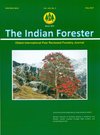Allometric Models for Estimating Tree Biomass and Soil Carbon Stocks of Small Scale Plantations in Subtropical-Subtemperate Regions of Western Himalayas
DOI:
https://doi.org/10.36808/if/2017/v143i5/114955Keywords:
Allometry, Biomass, Carbon Sequestration, Plantations, Soil Carbon.Abstract
Five plantations of Eucalyptus tereticornis, Populus deltoides, Quercus leucotrichophora, Eucalyptus tereticornis plus Pinus roxburghii and Quercus leucotrichophora plus Ulmus villosa were studied to access the total carbon sequestered by 24-25 year old farm plantations. Total 223 trees were enumerated and observations regarding stem, leaf, branch, above ground, below ground and total tree biomass were recorded by destructive and non destructive methods of sampling under different plantations and was converted into biomass carbon density. Per cent soil organic carbon and total soil carbon density was also determined. Mean biomass carbon and total biomass plus soil carbon density of different farm plantations varied from 150.50- 544.94 t ha-1 and followed the order: Eucalyptus tereticornis > Quercus leucotrichophora + Ulmus villosa > Populus deltoides > Eucalyptus tereticornis + Pinus roxburghii > Quercus leucotrichophora. Different generalized allometric equations were developed to estimate biomass carbon and biomass plus soil carbon stock for pure as well as mixed farm forestry plantations. For estimation of biomass and carbon in different pure and mixed stands of studied farm forestry species, diameter was taken as independent variable. Based on R2 value power function was the best fitted function for biomass carbon whereas compound function was best fitted for total biomass plus soil carbon in pure as well as mixed plantations.References
Baishya R., Barik S.S. and Upadhaya K. (2009). Distribution pattern of above ground biomass in natural and plantation forests of humid tropics in northeast India. Tropical Ecology, 50(2): 295-304.
Bitlerlich W. (1984). The relaskop idea slough: Common wealth Agricultural Bureasuse. Farnham Royal, England.
Cairns M.A., Brown S., Helmer E.N. and Baumgardener G.A. (1997). Root biomass allocation in the world's upland forests. Oecologia, 111:1-11.
Chidumaya E.N. (1990). Aboveground woody biomass structure and productivity in Zambezian Woodland. Forest Ecology and Management, 36: 33-46.
Devi B., Bhardwaj D.R., Panwar P., Pal S., Gupta N.K. and Thakur C.L. (2013). Carbon allocation, sequestration and carbon dioxide mitigation under plantation forests of north western Himalaya, India. Annuals of Forestry Research, 56(1):123-135.
IPCC (1996). Landuse Change and Forestry. In: Revised 1996 IPCC guidelines for National Greenhouse Gas Inventories. Cambridge University Press, Cambridge, U. K.
Kalra Y.P. and Maynard D.G. (1991). Methods manual for forest soil and plant analysis. Forestry Canada. North West Region. Alberta.
Mittal M.C., Rai M.P., Rawat J.K. and Singh J. (1991). Volume table for Acacia auriculiformis. Indian Forester, 117(8): 632-634.
Nelson D.W. and Sommers L.E. (1996). Total carbon, organic carbon and organic matter. In: Method of soil analysis. Part 3. Chemical methods. (eds. D.L. Sparks et al.) Soil Science Society of America, Madison, Wisconsin. pp. 961-1010.
Niles J.O., Brown S., Pretty J., Ball A.S. and Fay J. (2002). Potential carbon mitigation and income in developing countries from changes in use and management of agricultural and forest lands. Phil. Trans. Math. Phys. Eng. Sci., 360: 1621–1639.
Sanyam (2012). Studies on biomass partitioning and soil enrichment in plantations of different tree species under mid hill conditions of Himachal Pradesh, M. Sc, Thesis. Dr. Y. S. Parmar University of Horticulture and Forestry, Nauni, Solan (H. P.): 83pp.
Schroeder P.S., Brown J.M., Birdsey R. and Cieszewski C. (1997). Biomass estimation for temperate broadleaf forest of the United States using inventory data. Forestry Science, 43: 424-434.
Segura M. and Kanninen M. (2005). Allometric models for tree volume and total aboveground biomass in tropical humid forest in Costa Rica. Biotropica, 37 (1): 2-8.
Sharma C.M., Baduni N.P., Gairola S., Ghildiyal S.K. and Suyal S. (2010). The effect of slope aspects on the forest composition, community structure and soil nutrient status of some major natural temperate forest types of Garhwal Himalaya. Journal of Forest Research, 21(3): 331-337.
Singh R.A. (1980). Soil physical analysis. Kalyani Publishers. New Delhi. pp 61-62.
Singh V., Tewari A., Kushwaha S.P.S., and Dadhwal V.K. (2011). Formulating allometric equations for estimating biomass and carbon stock in small diameter trees. Forest Ecology and Management, 261: 1945–1949.
Temesgen H., Affleck D., Poudel K., Gray A. and Sessions J. (2015). A review of the challenges and opportunities in estimating above ground forest biomass using tree-level models. Scandinavian J. Forest Research, 30(4): 326-335.
Ter-Mikaelian M.T. and Korzukhin M.D. (1997). Biomass equations for sixty five North American tree species. Forest Ecology and Management, 97:1-24.
Tiwari A.K. and Singh J.S. (1987). Analysis of forest land-use and vegetation in a part of Central Himalaya, using aerial photographs. Environment Conservation, 14: 233-244.
UNFCCC (United Nations Framework Convention on Climate Change). (2008). Report of the Conference of the Parties on its thirteenth session, held in Bali. 3-15 December, 2007. Addendum, Part 2. Document FCCC/CP/2007/6/Add.1. UNFCCC, Bonn, Germany.
Van Dijk A.I.J.M. and Keenan R.J. (2007). Planted forests and water in perspective. Forest Ecology and Management, 251: 1–9.
Walkley A.J. and Black A. (1934). Estimation of soil organic carbon by chromic acid titration method. Soil Science, 37: 29-38.
Wang H., Hall C.A.S., Scatena F.N., Fetcher N. and Wu W. (2003). Modeling the spatial and temporal variability in climate and primary productivity across the Luquillo mountains, Puerto Rico. Forest Ecology and Management, 179: 69–94.
Downloads
Downloads
Published
How to Cite
Issue
Section
License
Unless otherwise stated, copyright or similar rights in all materials presented on the site, including graphical images, are owned by Indian Forester.





